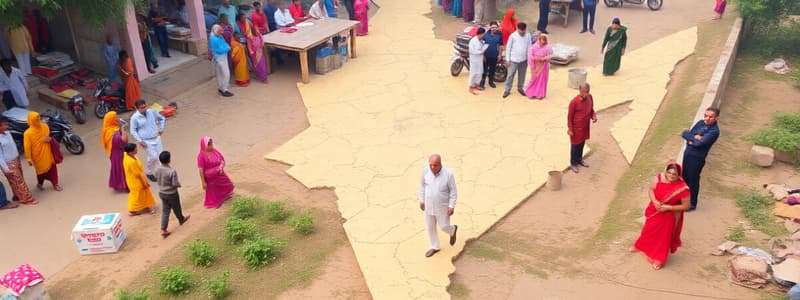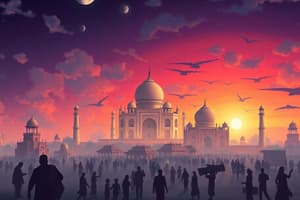Podcast
Questions and Answers
What was the approximate population density of India, per square kilometer, in 2011?
What was the approximate population density of India, per square kilometer, in 2011?
- 382 (correct)
- 1102
- 17
- 1210
In 2011, which state in India had the highest population density, according to the text?
In 2011, which state in India had the highest population density, according to the text?
- Bihar (correct)
- Jammu and Kashmir
- Telangana
- Arunachal Pradesh
Which of these states had the lowest population density in India, as per the provided text?
Which of these states had the lowest population density in India, as per the provided text?
- Bihar
- Arunachal Pradesh (correct)
- Telangana
- Jammu and Kashmir
What is the primary factor cited for low population densities in certain areas?
What is the primary factor cited for low population densities in certain areas?
What does an annual growth rate of 2% mean in terms of population increase?
What does an annual growth rate of 2% mean in terms of population increase?
What primary type of information is gathered through the census of India?
What primary type of information is gathered through the census of India?
What was the approximate population of India in 1951, according to the text?
What was the approximate population of India in 1951, according to the text?
In what year was the first complete census conducted in India?
In what year was the first complete census conducted in India?
Which geographical feature is NOT stated as a reason for moderate population density?
Which geographical feature is NOT stated as a reason for moderate population density?
Approximately how much of the world's area is accounted for by India?
Approximately how much of the world's area is accounted for by India?
Which regions tend to have high to very high population densities?
Which regions tend to have high to very high population densities?
What was the key demographic trend observed in India's population between 1951 and 2011?
What was the key demographic trend observed in India's population between 1951 and 2011?
How often are censuses conducted in India, based on the provided information?
How often are censuses conducted in India, based on the provided information?
What dynamic effect(s) on population is produced through the interaction of births, deaths and migrations?
What dynamic effect(s) on population is produced through the interaction of births, deaths and migrations?
Which state, despite being the largest by area, holds only a small percentage of India's total population?
Which state, despite being the largest by area, holds only a small percentage of India's total population?
What does population density measure?
What does population density measure?
What trend was observed in the annual rate of population growth between 1951 and 1981?
What trend was observed in the annual rate of population growth between 1951 and 1981?
Which countries have a higher average population density than India?
Which countries have a higher average population density than India?
Which period saw a decrease in the rate of population growth, according to the text?
Which period saw a decrease in the rate of population growth, according to the text?
What percentage of the world's population lives in India, according to the provided text?
What percentage of the world's population lives in India, according to the provided text?
Despite the decline in growth rates since 1981 what has continued to steadily increase?
Despite the decline in growth rates since 1981 what has continued to steadily increase?
What is NOT mentioned as a factor contributing to high population densities in the Northern Plains and Kerala?
What is NOT mentioned as a factor contributing to high population densities in the Northern Plains and Kerala?
What caused the rapid population increase from 1951 to 1981?
What caused the rapid population increase from 1951 to 1981?
What is a major 'push' factor contributing to rural-to-urban migration in India?
What is a major 'push' factor contributing to rural-to-urban migration in India?
Besides population size, what does migration significantly affect?
Besides population size, what does migration significantly affect?
What has been the result of rural-urban migration in India?
What has been the result of rural-urban migration in India?
What is the primary aim of India's Family Welfare Programme?
What is the primary aim of India's Family Welfare Programme?
What crucial issue addressed by the National Population Policy of 2000 is also related to the development and safety of adolescent girls?
What crucial issue addressed by the National Population Policy of 2000 is also related to the development and safety of adolescent girls?
What is one of the key provisions of the NPP 2000 regarding education?
What is one of the key provisions of the NPP 2000 regarding education?
What was the primary concern that led the Indian government to initiate the Family Planning Programme in 1952?
What was the primary concern that led the Indian government to initiate the Family Planning Programme in 1952?
Which of the following is a key target that the National Population Policy 2000 aims to achieve?
Which of the following is a key target that the National Population Policy 2000 aims to achieve?
What is the primary characteristic of an alluvial plain?
What is the primary characteristic of an alluvial plain?
Which of the following best describes the term 'biome'?
Which of the following best describes the term 'biome'?
What does the term 'depression' refer to in meteorology?
What does the term 'depression' refer to in meteorology?
How is 'dependency ratio' calculated?
How is 'dependency ratio' calculated?
What does the term 'ecosystem' primarily refer to?
What does the term 'ecosystem' primarily refer to?
In geology, what is a 'fault'?
In geology, what is a 'fault'?
What does 'fauna' specifically refer to?
What does 'fauna' specifically refer to?
What geological feature is formed from the compression of the Earth's crust?
What geological feature is formed from the compression of the Earth's crust?
What term describes the movement of people out of a country?
What term describes the movement of people out of a country?
A city with a population exceeding one million is best identified as a:
A city with a population exceeding one million is best identified as a:
What weather phenomenon is characterized by a complete reversal of wind patterns over a large geographic area?
What weather phenomenon is characterized by a complete reversal of wind patterns over a large geographic area?
Which term refers to a large, relatively flat area of land that is elevated?
Which term refers to a large, relatively flat area of land that is elevated?
What scientific concept explains the movement of the Earth's crust?
What scientific concept explains the movement of the Earth's crust?
What is meant by the term 'relief' in the context of geography?
What is meant by the term 'relief' in the context of geography?
What is subsidence, in the context of meteorology?
What is subsidence, in the context of meteorology?
Which type of rock is generally formed from layered sediment?
Which type of rock is generally formed from layered sediment?
Flashcards
What is a census?
What is a census?
The process of officially counting the number of people in a country at regular intervals.
What is population?
What is population?
The number of people living in a specific area.
What is population density?
What is population density?
The average number of people living in a unit of area, usually per square kilometer.
What is population distribution?
What is population distribution?
Signup and view all the flashcards
Why is population distribution uneven in India?
Why is population distribution uneven in India?
Signup and view all the flashcards
What is population growth?
What is population growth?
Signup and view all the flashcards
What information does the Indian Census provide?
What information does the Indian Census provide?
Signup and view all the flashcards
Explain the Indian Census.
Explain the Indian Census.
Signup and view all the flashcards
Annual population growth rate
Annual population growth rate
Signup and view all the flashcards
Population
Population
Signup and view all the flashcards
Natural increase
Natural increase
Signup and view all the flashcards
Migration
Migration
Signup and view all the flashcards
Population distribution
Population distribution
Signup and view all the flashcards
Population density
Population density
Signup and view all the flashcards
Population change
Population change
Signup and view all the flashcards
Absolute increase in population
Absolute increase in population
Signup and view all the flashcards
Arunachal Pradesh
Arunachal Pradesh
Signup and view all the flashcards
Annual Growth Rate
Annual Growth Rate
Signup and view all the flashcards
Bihar
Bihar
Signup and view all the flashcards
India's Share of World's Population
India's Share of World's Population
Signup and view all the flashcards
Uneven Distribution of Population
Uneven Distribution of Population
Signup and view all the flashcards
Correlation between Maps
Correlation between Maps
Signup and view all the flashcards
Factors Influencing Population Density
Factors Influencing Population Density
Signup and view all the flashcards
Push Factors
Push Factors
Signup and view all the flashcards
Pull Factors
Pull Factors
Signup and view all the flashcards
Population Composition
Population Composition
Signup and view all the flashcards
National Population Policy (NPP)
National Population Policy (NPP)
Signup and view all the flashcards
Family Planning
Family Planning
Signup and view all the flashcards
Urban Population
Urban Population
Signup and view all the flashcards
Alluvial Plain
Alluvial Plain
Signup and view all the flashcards
Base Population
Base Population
Signup and view all the flashcards
Biome
Biome
Signup and view all the flashcards
Birth Rate
Birth Rate
Signup and view all the flashcards
Depression
Depression
Signup and view all the flashcards
Death Rate
Death Rate
Signup and view all the flashcards
Density of Population
Density of Population
Signup and view all the flashcards
Dependency Ratio
Dependency Ratio
Signup and view all the flashcards
Monsoon
Monsoon
Signup and view all the flashcards
Plateau
Plateau
Signup and view all the flashcards
Plate tectonics
Plate tectonics
Signup and view all the flashcards
Relief
Relief
Signup and view all the flashcards
Subsidence
Subsidence
Signup and view all the flashcards
Sedimentary rocks
Sedimentary rocks
Signup and view all the flashcards
Study Notes
Population Size and Distribution
India's population in March 2011 was 1,210.6 million, representing over 17% of the world's population.
This population is unevenly distributed across 3.28 million square km (2.4% of the world's area).
Uttar Pradesh (199 million) has the largest population in the country, about 16% of the total.
Sikkim (0.6 million) and Lakshadweep (64,429) have significantly smaller populations.
Nearly half of India's population resides in five states: Uttar Pradesh, Maharashtra, Bihar, West Bengal, and Andhra Pradesh.
Rajasthan, India's largest state by area, contains only 5.5% of the total population.
Census
A census is an official population count done periodically.
The first official census in India was in 1872, but a complete one was taken in 1881.
India conducts a census every 10 years, with the most recent being in 2011.
The census provides comprehensive demographic, social, and economic data.
Population Density
Population density is calculated as the number of people per square kilometer.
India's population density in 2011 was 382 per sq km.
Bihar had a density of 1,102 per sq km, while Arunachal Pradesh had only 17 per sq km.
Population density varies significantly across Indian states.
Population Growth
India's population has increased steadily since 1951, from 361 million to 1,210 million in 2011.
The annual growth rate fluctuated over various decades from 1951 through 2011.
The annual growth rate declined after 1981 despite an increase in the total population increase.
Factors Affecting Population Distribution
Differences in terrain and climate negatively impact population in some areas, resulting in sparse distribution.
Dense population often correlates with fertile land, abundant rainfall, and better living conditions.
Migration plays a substantial role in modifying population distribution and composition both internally and internationally.
Studying That Suits You
Use AI to generate personalized quizzes and flashcards to suit your learning preferences.




